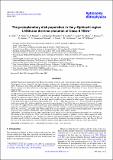Files in this item
The protoplanetary disk population in the ρ-Ophiuchi region L1688 and the time evolution of Class II YSOs
Item metadata
| dc.contributor.author | Testi, L. | |
| dc.contributor.author | Natta, A. | |
| dc.contributor.author | Manara, C. F. | |
| dc.contributor.author | de Gregorio Monsalvo, I. | |
| dc.contributor.author | Lodato, G. | |
| dc.contributor.author | Lopez, C. | |
| dc.contributor.author | Muzic, K. | |
| dc.contributor.author | Pascucci, I. | |
| dc.contributor.author | Sanchis, E. | |
| dc.contributor.author | Miranda, A. Santamaria | |
| dc.contributor.author | Scholz, A. | |
| dc.contributor.author | De Simone, M. | |
| dc.contributor.author | Williams, J. P. | |
| dc.date.accessioned | 2022-11-18T17:30:15Z | |
| dc.date.available | 2022-11-18T17:30:15Z | |
| dc.date.issued | 2022-07-19 | |
| dc.identifier | 282198044 | |
| dc.identifier | 3506a698-70cd-4a47-96be-529c89bae465 | |
| dc.identifier | 85134499518 | |
| dc.identifier | 000827180900008 | |
| dc.identifier.citation | Testi , L , Natta , A , Manara , C F , de Gregorio Monsalvo , I , Lodato , G , Lopez , C , Muzic , K , Pascucci , I , Sanchis , E , Miranda , A S , Scholz , A , De Simone , M & Williams , J P 2022 , ' The protoplanetary disk population in the ρ-Ophiuchi region L1688 and the time evolution of Class II YSOs ' , Astronomy & Astrophysics , vol. 663 , A98 . https://doi.org/10.1051/0004-6361/202141380 | en |
| dc.identifier.issn | 0004-6361 | |
| dc.identifier.other | RIS: urn:E2FF2DC0FE4C58C5107CD8FEFCFACF38 | |
| dc.identifier.other | RIS: 10.105100046361202141380 | |
| dc.identifier.uri | https://hdl.handle.net/10023/26439 | |
| dc.description | Funding information: This project has received funding from the European Union’s Horizon 2020 research and innovation programme under the Marie Sklodowska-Curie grant agreement No 823823 (DUSTBUSTERS) and from the European Research Council (ERC) via the ERC Synergy Grant ECOGAL (grant 855130), and the ERC Advanced Grant The Dawn of Organic Chemistry (grant 741002). | en |
| dc.description.abstract | Context. Planets form during the first few Myr of the evolution of the star-disk system, possibly before the end of the embedded phase. The properties of very young disks and their subsequent evolution reflect the presence and properties of their planetary content. Aims. We present a study of the Class II/F disk population in L1688, the densest and youngest region of star formation in Ophiuchus. We also compare it to other well-known nearby regions of different ages, namely Lupus, Chamaeleon I, Corona Australis, Taurus and Upper Scorpius. Methods. We selected our L1688 sample using a combination of criteria (available ALMA data, Gaia membership, and optical and near-IR spectroscopy) to determine the stellar and disk properties, specifically stellar mass (M⋆), average population age, mass accretion rate (Ṁacc) and disk dust mass (Ṁdust). We applied the same procedure in a consistent manner to the other regions. Results. In L1688 the relations between Ṁacc and M⋆, Mdust and M⋆, and Ṁacc and Mdust have a roughly linear trend with slopes 1.8–1.9 for the first two relations and ~1 for the third, which is similar to what found in the other regions. When ordered according to the characteristic age of each region, which ranging from ~ 0.5 to ~5 Myr, Ṁacc decreases as t−1, when corrected for the different stellar mass content; Mdust follows roughly the same trend, ranging between 0.5 and 5 Myr, but has an increase of a factor of ~3 at ages of 2–3 Myr. We suggest that this could result from an earlier planet formation, followed by collisional fragmentation that temporarily replenishes the millimeter-size grain population. The dispersion of Ṁacc and Mdust around the best-fitting relation with M⋆, as well as that of Ṁacc versus Mdust are equally large. When adding all the regions together to increase the statistical significance, we find that the dispersions have continuous distributions with a log-normal shape and similar widths (~0.8 dex). Conclusions. This detailed study of L1688 confirms the general picture of Class II/F disk properties and extends it to a younger age. The amount of dust observed at ~1 Myr is not sufficient to assemble the majority of planetary systems, which suggests an earlier formation process for planetary cores. The dust mass traces to a large extent the disk gas mass evolution, even if the ratio Mdust/Mdisk at the earliest age (0.5–1 Myr) is not known. Two properties are still not understood: the steep dependence of Ṁacc and Mdust on M⋆ and the cause of the large dispersion in the three relations analyzed in this paper, in particular that of the Ṁacc versus Mdust relation. | |
| dc.format.extent | 22 | |
| dc.format.extent | 4201476 | |
| dc.language.iso | eng | |
| dc.relation.ispartof | Astronomy & Astrophysics | en |
| dc.subject | Protoplanetary disks | en |
| dc.subject | Submillimeter: planetary systems | en |
| dc.subject | Stars: formation | en |
| dc.subject | QB Astronomy | en |
| dc.subject | QC Physics | en |
| dc.subject | 3rd-DAS | en |
| dc.subject | MCC | en |
| dc.subject.lcc | QB | en |
| dc.subject.lcc | QC | en |
| dc.title | The protoplanetary disk population in the ρ-Ophiuchi region L1688 and the time evolution of Class II YSOs | en |
| dc.type | Journal article | en |
| dc.contributor.sponsor | European Research Council | en |
| dc.contributor.institution | University of St Andrews. School of Physics and Astronomy | en |
| dc.contributor.institution | University of St Andrews. St Andrews Centre for Exoplanet Science | en |
| dc.identifier.doi | 10.1051/0004-6361/202141380 | |
| dc.description.status | Peer reviewed | en |
| dc.identifier.url | https://arxiv.org/abs/2201.04079 | en |
| dc.identifier.grantnumber | en |
This item appears in the following Collection(s)
Items in the St Andrews Research Repository are protected by copyright, with all rights reserved, unless otherwise indicated.

